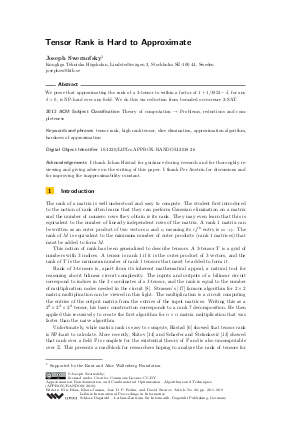Tensor Rank is Hard to Approximate
Author Joseph Swernofsky
-
Part of:
Volume:
Approximation, Randomization, and Combinatorial Optimization. Algorithms and Techniques (APPROX/RANDOM 2018)
Part of: Series: Leibniz International Proceedings in Informatics (LIPIcs)
Part of: Conference: International Conference on Randomization and Computation (RANDOM)
Part of: Conference: International Conference on Approximation Algorithms for Combinatorial Optimization Problems (APPROX) - License:
 Creative Commons Attribution 3.0 Unported license
Creative Commons Attribution 3.0 Unported license
- Publication Date: 2018-08-13
File

PDF
LIPIcs.APPROX-RANDOM.2018.26.pdf
- Filesize: 424 kB
- 9 pages
Document Identifiers
Subject Classification
ACM Subject Classification
- Theory of computation → Problems, reductions and completeness
Keywords
- tensor rank
- high rank tensor
- slice elimination
- approximation algorithm
- hardness of approximation
Metrics
- Access Statistics
-
Total Accesses (updated on a weekly basis)
0PDF Downloads0Metadata Views
Abstract
We prove that approximating the rank of a 3-tensor to within a factor of 1 + 1/1852 - delta, for any delta > 0, is NP-hard over any field. We do this via reduction from bounded occurrence 2-SAT.
Cite As Get BibTex
Joseph Swernofsky. Tensor Rank is Hard to Approximate. In Approximation, Randomization, and Combinatorial Optimization. Algorithms and Techniques (APPROX/RANDOM 2018). Leibniz International Proceedings in Informatics (LIPIcs), Volume 116, pp. 26:1-26:9, Schloss Dagstuhl – Leibniz-Zentrum für Informatik (2018)
https://doi.org/10.4230/LIPIcs.APPROX-RANDOM.2018.26
BibTex
@InProceedings{swernofsky:LIPIcs.APPROX-RANDOM.2018.26,
author = {Swernofsky, Joseph},
title = {{Tensor Rank is Hard to Approximate}},
booktitle = {Approximation, Randomization, and Combinatorial Optimization. Algorithms and Techniques (APPROX/RANDOM 2018)},
pages = {26:1--26:9},
series = {Leibniz International Proceedings in Informatics (LIPIcs)},
ISBN = {978-3-95977-085-9},
ISSN = {1868-8969},
year = {2018},
volume = {116},
editor = {Blais, Eric and Jansen, Klaus and D. P. Rolim, Jos\'{e} and Steurer, David},
publisher = {Schloss Dagstuhl -- Leibniz-Zentrum f{\"u}r Informatik},
address = {Dagstuhl, Germany},
URL = {https://drops.dagstuhl.de/entities/document/10.4230/LIPIcs.APPROX-RANDOM.2018.26},
URN = {urn:nbn:de:0030-drops-94309},
doi = {10.4230/LIPIcs.APPROX-RANDOM.2018.26},
annote = {Keywords: tensor rank, high rank tensor, slice elimination, approximation algorithm, hardness of approximation}
}
Author Details
Funding
- Swernofsky, Joseph: Supported by the Knut and Alice Wallenberg Foundation.
References
- Boris Alexeev, Michael A. Forbes, and Jacob Tsimerman. Tensor rank: Some lower and upper bounds. CoRR, abs/1102.0072, 2011. URL: http://arxiv.org/abs/1102.0072.
- Piotr Berman and Marek Karpinski. Efficient amplifiers and bounded degree optimization. Electronic Colloquium on Computational Complexity (ECCC), 8(53), 2001. URL: http://eccc.hpi-web.de/eccc-reports/2001/TR01-053/index.html.
- Markus Bläser. On the complexity of the multiplication of matrices of small formats. J. Complexity, 19(1):43-60, 2003. URL: http://dx.doi.org/10.1016/S0885-064X(02)00007-9.
-
Markus Bläser. Explicit tensors. In Perspectives in Computational Complexity, pages 117-130. Springer, 2014.

- Markus Bläser, Christian Ikenmeyer, Gorav Jindal, and Vladimir Lysikov. Generalized matrix completion and algebraic natural proofs. Electronic Colloquium on Computational Complexity (ECCC), 25:64, 2018. URL: https://eccc.weizmann.ac.il/report/2018/064.
- Johan Håstad. Tensor rank is np-complete. J. Algorithms, 11(4):644-654, 1990. URL: http://dx.doi.org/10.1016/0196-6774(90)90014-6.
- Tamara G. Kolda and Brett W. Bader. Tensor decompositions and applications. SIAM Review, 51(3):455-500, 2009. URL: http://dx.doi.org/10.1137/07070111X.
-
Joseph B Kruskal. Three-way arrays: rank and uniqueness of trilinear decompositions, with application to arithmetic complexity and statistics. Linear algebra and its applications, 18(2):95-138, 1977.

-
Julian D Laderman. A noncommutative algorithm for multiplying 3× 3 matrices using 23 multiplications. Bulletin of the American Mathematical Society, 82(1):126-128, 1976.

- J. M. Landsberg and Mateusz Michalek. Abelian tensors. CoRR, abs/1504.03732, 2015. URL: http://arxiv.org/abs/1504.03732.
-
Viñtor Yakovlevich Pan. Methods of computing values of polynomials. Russian Mathematical Surveys, 21(1):105-136, 1966.

- Ran Raz. Tensor-rank and lower bounds for arithmetic formulas. Electronic Colloquium on Computational Complexity (ECCC), 17:2, 2010. URL: http://eccc.hpi-web.de/report/2010/002.
- Marcus Schaefer and Daniel Stefankovic. The complexity of tensor rank. CoRR, abs/1612.04338, 2016. URL: http://arxiv.org/abs/1612.04338.
-
Yaroslav Shitov. How hard is the tensor rank? arXiv preprint arXiv:1611.01559, 2016.

- Amir Shpilka. Lower bounds for matrix product. CoRR, cs.CC/0201001, 2002. URL: http://arxiv.org/abs/cs.CC/0201001.
- Zhao Song, David P. Woodruff, and Peilin Zhong. Relative error tensor low rank approximation. CoRR, abs/1704.08246, 2017. URL: http://arxiv.org/abs/1704.08246.
-
Volker Strassen. Gaussian elimination is not optimal. Numerische mathematik, 13(4):354-356, 1969.

-
Nengkun Yu, Eric Chitambar, Cheng Guo, and Runyao Duan. Tensor rank of the tripartite state |w⟩^⊗ n. Physical Review A, 81(1):014301, 2010.

